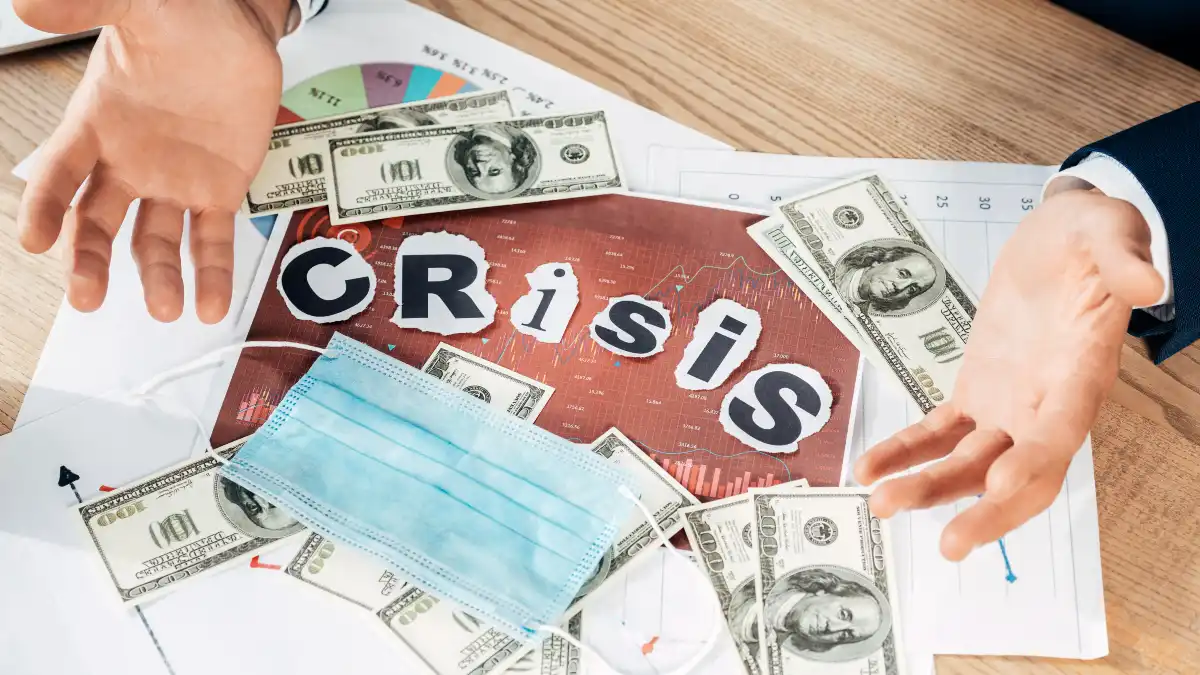The economic landscape of 2025 presents a confusing paradox: while celebrate cooling inflation, households struggle with stubbornly high costs.
This guide deciphers this disconnect, identifying “sticky prices” as the primary culprit. It delves into why essential costs like rent, insurance, and medical services resist falling, even as prices for volatile goods like gasoline decline.
By exploring the economic drivers behind this phenomenon, the real impact on wages, and the psychology of consumer perception, this analysis explains the new high-cost normal and provides actionable financial strategies for consumers to build resilience and navigate this challenging environment successfully.
The Mechanics of Price Stickiness: Why Some Costs Refuse to Fall

The “Sticky-Down” Phenomenon
A key characteristic of sticky prices is their asymmetry: they tend to rise far more easily than they fall. This behavior, often described as rockets and feathers, is formally known in economics as the “sticky-down” phenomenon.
It refers to the tendency of a price to adjust upward quickly in response to cost increases or demand surges but to resist downward adjustments when those conditions reverse.
This resistance is a primary reason why the high price levels established during a period of intense inflation become the new, lasting reality for consumers.
The drivers of this downward rigidity are multifaceted, stemming from a combination of market structure, information gaps, and deliberate business strategy.
Economists point to three main causes: imperfect information, where firms are uncertain if a drop in their costs is temporary or permanent; market distortions, such as a lack of competition; and, most commonly, firms making rational decisions to maximize profit in the short term.
When a firm’s input costs fall, it faces a choice: pass the savings on to the consumer by lowering prices, or maintain the current price and absorb the difference as a wider profit margin.
In many cases, especially for essential goods where demand is relatively inelastic, the incentive to choose the latter is strong.
The market for gasoline provides a classic and readily observable example of sticky-down pricing. When the global price of crude oil spikes, the price at the pump often rises almost immediately, with retailers passing the increased cost directly to consumers.
However, when the price of crude oil falls, the corresponding drop in gasoline prices is often sluggish and incomplete. This lag can be attributed to several factors.
Station owners may still be working through higher-priced inventory, or they may face genuine delays in securing new supply at the lower cost. More frequently, however, it reflects a strategic decision to capitalize on consumer expectations.
Having become accustomed to the higher price, consumers are less likely to dramatically alter their purchasing behavior in response to a price that is falling slowly, allowing retailers to capture higher profits during the adjustment period.
This behavior is not limited to energy markets and can be observed in other commodities as well. From a consumer perspective, the sticky-down phenomenon often breeds resentment and a sense of being exploited.
When the public sees the price of a raw material fall but the price of the finished good does not, it can be perceived as price gouging, eroding trust in businesses and the market system.
This dynamic is particularly potent for necessities that consumers cannot easily forgo, creating a ratchet effect where prices ascend in sharp steps during crises but descend in slow, shallow slopes during periods of calm, locking in a higher price floor over time.
Once consumers have psychologically adjusted to a higher price—a new anchor point—the competitive pressure on firms to lower it diminishes, reinforcing the persistence of the high-cost environment.
Unpacking the Drivers of Stickiness

The resistance of prices to downward adjustment is not merely a matter of short-term opportunism.
It is rooted in deep structural factors within the economy that create significant friction and costs associated with changing prices.
Understanding these drivers—menu costs, wage rigidity, and the nature of contracts and market competition—is essential to comprehending why the current high-cost environment is so persistent.
Menu Costs in the Digital Age
The concept of menu costs is a foundational explanation for price stickiness. The term originated from the literal, tangible cost a restaurant incurs to design, print, and distribute new menus when it changes its prices.
While this classic example remains relevant, the concept has evolved to encompass a much broader and more complex set of costs that firms face when implementing any price change, particularly in the modern digital economy.
Today, menu costs are less about paper and ink and more about the comprehensive resources required to execute a price adjustment. These modern costs can be categorized as follows:
Administrative and Labor Costs:
This includes the person-hours required for employees to update pricing information across a multitude of platforms, such as internal computer systems, e-commerce websites, third-party retail portals, and digital point-of-sale systems.
For physical retailers, it also involves the labor-intensive process of re-tagging merchandise on shelves and updating signage.
Communication and Marketing Costs:
A price change is not effective until customers and partners are aware of it. Firms must invest in communicating new prices to their distribution networks, sales teams, and the public through advertising and other marketing channels.
Customer Friction and Goodwill Costs:
In an omnichannel retail environment, price changes can create confusion and frustration for customers. A consumer might see one price on a digital menu or website and be charged a different, higher price at the register, leading to disputes and a loss of trust.
Furthermore, frequent price changes can make customers apprehensive, causing them to hesitate on purchases and potentially leading to lost sales—a subtle but significant menu cost.
Strategic and Analytical Costs:
Deciding on a new price is not a trivial matter. It often requires significant investment in market research, competitor analysis, and demand forecasting. Many firms hire external consultants to develop sophisticated pricing strategies, adding another layer of expense to any adjustment.
These costs are far from negligible. A landmark 1997 study of multi-store supermarket chains found that menu costs averaged more than 35% of the stores’ net profit margins.
This implies that the expected benefit from a price change must be substantial to justify incurring such a significant expense. As a result, firms are often hesitant to adjust prices in response to small or temporary fluctuations in their costs or market conditions, contributing directly to the phenomenon of price stickiness.
The Bedrock of Wages
Perhaps the most significant driver of sticky prices, especially in the modern service-dominated economy, is wage rigidity. Wages are, in effect, the price of labor, and they are the stickiest price in the entire economy.
The phenomenon of wage rigidity refers to the strong resistance of wages to downward adjustment, even during economic downturns when labor demand falls.
This downward stickiness is not irrational; it is deeply rooted in human psychology, social norms, and institutional structures:
Morale, Fairness, and Productivity:
Unlike the price of a commodity, a person’s wage is intimately tied to their sense of self-worth, fairness, and motivation. Employees overwhelmingly perceive a nominal wage cut as a personal insult and a violation of trust.
In response, morale plummets, and productivity often falls by more than the cost savings from the wage cut, making it a counterproductive move for employers.
Efficiency Wage Theory:
Some economic theories posit that firms intentionally pay wages above the market-clearing rate to attract a higher caliber of worker, reduce employee turnover, and encourage greater effort and loyalty.
Having made this strategic investment in their workforce, these firms are extremely reluctant to undermine it by cutting pay.
Contracts and Institutions:
The ability of firms to cut wages is often legally or institutionally constrained. Collective bargaining agreements negotiated by labor unions, legally mandated minimum wage laws, and even implicit, unwritten contracts between employers and employees create a floor below which wages cannot easily fall.
The connection between rigid wages and sticky prices is direct and powerful. For many businesses, particularly in the service sector (such as healthcare, hospitality, and education), labor costs represent the single largest expense, often accounting for up to 70% of total costs.
When faced with a decline in demand, a firm with rigid labor costs cannot afford to significantly lower the prices of its products or services.
Instead of cutting wages across the board, managers will almost invariably choose to lay off a portion of their workforce while maintaining the pay levels of the remaining employees.
This decision, while preserving morale among the survivors, means that the firm’s underlying cost structure remains high, preventing it from reducing prices for consumers and thus contributing to economy-wide price stickiness.
Contracts and Market Power
Beyond the internal costs faced by firms, the external environment of contracts and market competition plays a crucial role in cementing price rigidity.
Many economic transactions are governed by long-term contracts that lock in prices for extended periods, insulating them from short-term market fluctuations.
A business that signs a one-year lease for its office space, a manufacturer that agrees to a six-month supply contract with a vendor at a fixed price, or a consumer who signs a two-year contract for their mobile phone service are all participating in arrangements that create sticky prices by design.
These contractual obligations mean that even if broader economic conditions change, the prices for these specific goods and services remain fixed until the contract is renegotiated.
The structure of the market itself is also a powerful determinant of price stickiness. In highly competitive markets with many small firms, prices tend to be more flexible.
However, in an oligopoly—a market dominated by a small number of large firms—strategic interactions lead to a strong preference for price stability. Firms in an oligopoly are intensely aware of their rivals’ actions.
If one firm were to lower its prices to gain market share, it knows that its competitors would likely follow suit immediately, triggering a price war that would ultimately harm the profits of all firms involved.
Conversely, if one firm raises its prices, its rivals may not follow, causing it to lose customers. This dynamic, often explained by the “kinked demand curve” model in economics, creates a powerful incentive for all firms to maintain the existing price level, even in the face of changing cost or demand conditions.
This mutual reluctance to engage in price competition results in the stable, sticky prices characteristic of industries like telecommunications, airlines, and automobile manufacturing.
The increasing dominance of the service sector in advanced economies has structurally amplified the overall stickiness of the price level.
As industries like healthcare, education, and professional services—all of which are characterized by high, rigid labor costs—constitute a growing share of economic activity, the entire economy becomes less responsive to traditional market forces.
This means that in the face of a negative economic shock, the economy is less able to self-correct through flexible price adjustments and is instead more prone to prolonged periods of higher unemployment, posing a significant challenge for policymakers aiming to stabilize the economy.
The Data Deep Dive: Sticky vs. Flexible CPI in 2025

The theoretical drivers of price stickiness are validated by empirical data, which reveals a clear and widening chasm between the behavior of flexible and sticky prices in the current economy.
An analysis of the latest inflation data for August 2025, particularly the specialized indexes compiled by the Atlanta Fed, provides irrefutable evidence that the persistence of high costs is concentrated almost entirely within the sticky components of the consumer basket.
The headline Consumer Price Index (CPI) rose 2.9% on a year-over-year basis in August. However, disaggregating this number reveals two dramatically different stories.
The Flexible-Price CPI, which tracks volatile items, increased by a mere 1.6% over the past year. In stark contrast, the Sticky-Price CPI rose by 3.4% over the same period.
This divergence is the statistical proof of the consumer’s paradox: the elements of the economy that see rapid price changes have cooled significantly, while the slow-moving, structural costs that dominate household budgets remain stubbornly high.
The persistence is even clearer when examining the Core Sticky-Price CPI, which strips out the volatile food and energy components from the sticky basket to provide a measure of underlying, entrenched inflation.
This index also rose by 3.4% year-over-year, confirming that the trend is not an artifact of commodity shocks but is embedded in the service-based core of the economy.
The monthly data further illustrates the dynamic: in August, the annualized increase for the Sticky-Price CPI was a firm 3.6%, whereas the Flexible-Price CPI saw a volatile annualized surge of 7.9%, showcasing its erratic nature compared to the steady upward grind of sticky prices.
To understand where this persistent inflation is coming from, it is necessary to examine the specific categories within the CPI that are classified as sticky. Data from the Bureau of Labor Statistics highlights several key areas driving the high cost of living:
Shelter:
As the largest component of most household budgets, the shelter index increased by 3.6% over the last year, contributing significantly to the overall stickiness of inflation.
Medical Care Services:
The cost of medical care, a notoriously sticky category due to complex insurance contracts and high labor costs, rose by 3.4% over the past 12 months.
Motor Vehicle Insurance:
This category has seen particularly sharp increases, rising 4.7% over the last year according to one measure.
More recent analysis from August 2025 suggests an even higher annual increase of 5.3%, driven by the rising costs of vehicles and more expensive repairs.
Auto Repair Costs:
Directly linked to insurance rates, the cost of auto repairs has risen substantially, fueled in part by tariffs on the 60% of replacement parts that are imported.
The following table synthesizes this data, providing a clear, side-by-side comparison that visually represents the inflation divergence at the heart of the current economic disconnect.
Table 1: The Inflation Divergence (Year-Over-Year % Change, August 2025)
| Index | Year-Over-Year % Change | August 2025 Annualized Monthly Change | Key Components |
| Headline CPI (All Items) | 2.9% | 4.8% (0.4% monthly) | Overall basket of goods and services |
| Flexible-Price CPI | 1.6% | 7.9% | Gasoline, food at home, energy |
| Sticky-Price CPI | 3.4% | 3.6% | Rent, insurance, medical care, services |
| Core Sticky-Price CPI (Less Food/Energy) | 3.4% | 3.6% | Excludes volatile items from the sticky basket, showing underlying persistence |
This table serves as the central piece of evidence for this report. It quantifies the disconnect felt by consumers, validating their experience that costs remain high.
The “inflation is down” narrative is statistically true when looking at flexible goods, but the “my costs aren’t” reality is powerfully confirmed by the persistent, above-average inflation in the sticky categories that constitute the bedrock of a household’s financial obligations.
The Human Element: Wages, Psychology, and Your Perception of Price

The Paycheck Predicament: Are Wages Truly Keeping Up?
The impact of persistently high prices is ultimately determined by their relationship to household income. The critical question for consumers is whether their paychecks are growing fast enough to offset the rising cost of living.
While top-line data suggests a recent positive trend, a deeper analysis reveals a more complex and challenging picture, where the financial damage from the initial inflation shock has not been fully repaired and a significant portion of the workforce continues to fall behind.
On the surface, the news appears positive. From July 2024 to July 2025, nominal average weekly wages grew by 4.2%.
With the headline inflation rate at 2.7% over the same period, this translates to a 1.5% increase in real (inflation-adjusted) wages. This data supports the narrative that, on average, wage growth is currently outpacing inflation, leading to a modest recovery in purchasing power.
This short-term view masks the deeper erosion of purchasing power that occurred during the peak of the inflation crisis. A longer-term perspective is necessary to understand the hole from which consumers are still emerging.
Since January 2021, the cumulative increase in the Consumer Price Index has been 22.7%. Over that same period, cumulative growth in average hourly earnings has been only 21.8%.
The result is that, as of mid-2025, real wages remain 0.7% lower than they were before the inflation surge began. While the recent trend is positive, the average worker has not yet fully recovered the purchasing power they lost.
Furthermore, national averages conceal significant disparities within the workforce. The “average” experience is not the universal one.
Analysis from June 2025 reveals that 43% of American workers saw their paychecks grow more slowly than the rate of inflation, meaning nearly half of the labor force is still actively losing ground financially.
This highlights a crucial aspect of the current economic environment: the benefits of recovery are not being distributed evenly.
The dynamics of wage growth across different pay levels add another layer of complexity.
In the immediate post-pandemic period, the tight labor market produced a surge in wage growth for low-paying jobs, which peaked at an extraordinary 11.5% annual rate in 2022.
This was a critical buffer that helped the most vulnerable households withstand the initial inflation shock. However, by mid-2025, this trend has ended. Wage growth has cooled and converged across all tiers, stabilizing at around 2.8% for low-wage jobs, 3.0% for middle-wage jobs, and 2.9% for high-wage jobs.
The “catch-up” mechanism for the lowest earners has expired. This convergence is a significant forward-looking indicator of potential financial distress.
As low-income households spend the largest portion of their budgets on sticky essentials like food, rent, and utilities, the combination of moderating wage growth and persistently high sticky-price inflation creates a severe financial squeeze that is far more acute than the national average data would suggest.
The following table provides a comprehensive view of the wage and inflation dynamic, presenting both the recent positive trend and the longer-term deficit to offer a complete and nuanced picture of the state of consumer purchasing power.
Table 2: The Battle for Purchasing Power (Cumulative & Year-Over-Year Change)
| Metric | Jul 2024 – Jul 2025 Change | Cumulative Change Since Jan 2021 | Implication for Consumers |
| Nominal Average Hourly Earnings | +4.2% | +21.8% | Paychecks are getting bigger in dollar terms. |
| Consumer Price Index (CPI) | +2.7% | +22.7% | The cost of living has risen faster than wages since the start of the inflation surge. |
| Real Average Hourly Earnings | +1.5% | -0.7% | Purchasing power has recently started to recover but has not yet overcome the deficit. |
This table validates the conflicting feelings of many consumers. It acknowledges the recent improvement in real wages, which aligns with more positive economic headlines.
While simultaneously confirming the lingering sense of being financially behind, a direct result of the cumulative deficit in purchasing power that has yet to be erased.
The Anchoring Effect: How Past Inflation Shapes Today’s Spending

The persistence of high prices is not solely a function of economic mechanics; it is also deeply intertwined with human psychology.
A key concept from the field of behavioral economics, the Anchoring Bias, helps to explain why consumers may be grudgingly accepting the new price reality, which in turn allows businesses to maintain those high prices.
The anchoring bias is a cognitive shortcut that causes individuals to rely heavily on the first piece of information they receive—the anchor—when making subsequent judgments and decisions.
A simple retail example illustrates this principle effectively. A shopper looking for a gift first encounters a pair of earrings priced at $100.
This price, though high, sets a powerful anchor in their mind. A few minutes later, they find a necklace for $75. Evaluated against the $100 anchor, the $75 necklace seems like a reasonable deal, even if it is still above their original budget.
Had they encountered the $75 necklace first, it would have served as the anchor, and it likely would have been perceived as expensive. The initial reference point fundamentally alters the perception of value.
This psychological phenomenon has profound implications in the current inflationary environment.
The peak inflation rates of 8-9% experienced in 2022 created an extremely high and potent anchor for consumers’ expectations about price increases. Having lived through a period where prices were rising at an alarming rate, consumers have psychologically “reset their anchors” to a much higher level.
Consequently, a price increase of 3% or 4% in 2025, while still eroding purchasing power, feels mild and manageable in comparison to the recent past.
The real-world behavior of gasoline prices provides a clear demonstration of this reset. When prices were anchored below $2.00 per gallon, a rise to $2.50 was met with significant consumer discontent.
However, after prices surged to over $4.00 per gallon and subsequently fell back to $2.50, that same price was perceived by many as a welcome relief. The objective price was the same, but the psychological context, framed by the new, higher anchor, was entirely different.
This cognitive bias provides a form of psychological cover for the “sticky-down” pricing strategies employed by businesses.
The primary constraint on a firm’s ability to maintain high prices in the face of falling costs is the risk of consumer backlash. The anchoring effect significantly mitigates this risk.
Because consumer attention and outrage are anchored to the high rate of change seen in the recent past, there is less public pressure on firms to reduce the absolute price level.
A price that is stable, even if high, is now perceived more favorably than a price that is rising rapidly. This creates a feedback loop where economic strategy and consumer psychology reinforce one another.
The initial inflation shock created a new psychological anchor, which allows firms to maintain sticky-down prices with less resistance, which in turn solidifies the high price level as the “new normal” in the minds of consumers.
Your Actionable Guide for Navigating the High-Cost Environment of 2025

Understanding the economic and psychological forces behind sticky prices is the first step; the second is to implement a robust financial strategy to navigate this challenging environment.
The persistence of high costs for essential goods and services, coupled with the central bank’s use of higher interest rates to combat this inflation, requires a proactive and tailored approach to personal finance.
The following guide provides actionable steps for fortifying your financial defenses in 2025.
Master Your Cash Flow with a Dynamic Budget
In an environment of high and inflexible costs, a static, “set-it-and-forget-it” budget is insufficient. Financial stability requires a dynamic and continuously evolving budget that provides a clear picture of where every dollar is going.
Actionable Advice:
Begin by meticulously tracking all income and expenses for at least one month to establish a baseline. Use budgeting apps or simple spreadsheets to categorize spending and identify areas of financial leakage. The goal is to ensure that monthly cash inflows consistently exceed outflows.
Critically distinguish between needs (housing, utilities, insurance) and wants (entertainment, dining out), and be prepared to make deliberate cuts to discretionary spending.
To combat high food prices—a major budget pressure point—adopt strategic grocery shopping habits.
Always shop with a detailed list to curb impulse buying, actively use coupons and loyalty programs, and plan weekly meals around sale items, especially for higher-cost products like meat and fresh produce.
Strategic Debt Management
The elevated interest rates used to fight sticky inflation make certain types of debt particularly hazardous. A strategic approach to debt is crucial to prevent financial erosion.
Actionable Advice:
Make it an absolute priority to aggressively pay down high-interest, variable-rate debt, most notably credit card balances. As central banks raise benchmark rates, the Annual Percentage Rate (APR) on this debt increases, causing interest charges to compound more quickly.
Consider strategies like debt consolidation into a single personal loan with a lower fixed rate or using a balance transfer credit card that offers a 0% introductory APR. Conversely, low-interest, fixed-rate debt, such as a mortgage secured in 2020 or 2021, is a much lower priority.
In fact, high inflation works to your advantage with this type of debt, as you are repaying the loan with dollars that are worth less than when you borrowed them.
Build an Inflation-Ready Emergency Fund
An emergency fund is the bedrock of financial security, and its importance is magnified in a sticky-price world where essential costs are both high and inflexible.
Actionable Advice:
The standard rule of thumb is to save three to six months’ worth of essential living expenses. In the current environment, it is prudent to aim for the higher end of this range.
These funds must be kept in a liquid, easily accessible account—not invested in the stock market.
A high-yield savings account or a money market account is ideal, as this will allow your cash to earn some interest to partially offset the erosive effect of inflation, rather than earning nothing in a traditional checking account.
This fund is your primary defense against unexpected events like a job loss or medical emergency, preventing you from having to take on high-interest debt to cover inflexible costs like rent or insurance payments.
Invest for the Long Term, Not for the Moment
While high inflation and market volatility can be unsettling, making reactive, emotional decisions with your long-term investments is often a costly mistake.
Actionable Advice:
Maintain a disciplined, long-term perspective. The primary purpose of investing is to grow your wealth at a rate that outpaces inflation over decades, not months.
Adhere to a diversified portfolio strategy, with a mix of stocks, bonds, and other asset classes appropriate for your age and risk tolerance.
To specifically hedge against inflation, consider including assets that have historically performed well in such environments.
These can include real assets like real estate, where rental income can be adjusted for inflation, or the stocks of well-established companies with strong pricing power and low levels of debt, which are less vulnerable to rising interest rates.
Proactively Grow Your Income
A comprehensive financial strategy involves both defense (cutting costs) and offense (increasing income). In an era of rising costs, relying solely on expense reduction can be a losing battle.
Actionable Advice:
Take proactive steps to ensure your income keeps pace with the cost of living. Research industry salary benchmarks for your role and experience level, and be prepared to negotiate a raise with your employer, using your performance and market data as leverage.
Beyond your primary job, consider developing new, in-demand skills that can increase your future earning potential. Exploring a side hustle or freelance work can also provide a valuable additional income stream, diversifying your earnings and creating a greater financial buffer.
The optimal financial approach in a sticky-price environment is one of structured flexibility.
This requires creating rigid discipline around the most dangerous financial elements—variable-rate debt and discretionary overspending—while simultaneously building maximum flexibility through a large, liquid cash reserve.
Standard financial advice must be adapted for a world where a significant portion of a household’s budget is both high and unchangeable.
This barbell strategy of extreme risk aversion on one end (debt) and extreme liquidity on the other (savings) is uniquely suited to the specific economic challenges of 2025.

